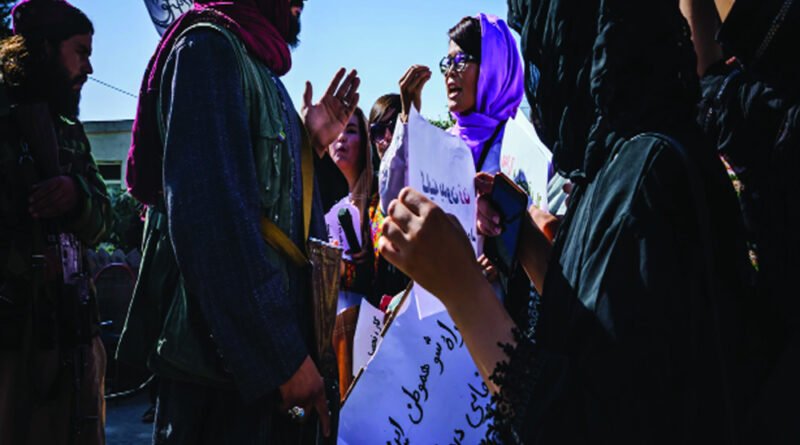Where are abducted Afghan activists?
The Taliban must stop feigning ignorance and immediately release the six female activists who were abducted, and subsequently disappeared
The Associated Press has reported that, according to the Taliban, universities reopened, for both men and women, in six of Afghanistan’s 34 provinces on February 2, 2022. They had started with six provinces — Nangarhar, Kandahar, Helmand, Farah, Nimroz and Laghman — because these are warmer than the rest of the country where winter is bitterly cold. Eventually, all men and women will return to universities. Co-education, however, is out. In keeping with the Taliban’s policy of gender-segregated education, men will attend classes in the morning, and women in the afternoon.
This development merits a welcome, particularly since the Taliban have kept their promise. Their Acting Minister for Higher Education, Abdul Baqi Haqqani, had announced at a press conference in Kabul on January 12 that the Government would soon reopen the universities for both male and female students. Saying that male and female students would be taught separately, he had attributed the delay in reopening the universities to the lack of infrastructure for this as well as the economic crisis afflicting Afghanistan.
The Taliban, however, have miles to go before they can come even close to honouring some of the basic human rights of women and girls. At the time of writing, girls in classes above six cannot attend schools; boys can. Women are allowed to work only in some segments of the health and education sectors, and that too under severe restrictions. They can venture out of their houses only in the company of “close” male relatives, and that too fully covered in burqas. Not one of the “interim” Ministers in the Taliban Government is a woman, though, according to Zabihullah Mujtahid, Acting Deputy Minister for Information and Culture; there may be one in the future. Indeed, things have been carried to a ludicrous extent: The telecast of IPL matches was banned as women were seen among the spectators!
This is an absolute pity. Women had taken significant strides forward after the ouster of the first Taliban Government, which had put them virtually under house arrest, in 2001. As George R Allen and Wanda Felbab-Brown state in their paper, Fate of Women’s Rights in Afghanistan, which is a part of Brookings Institution’s 19A Gender Equality Series, the 2004-post Taliban Constitution “gave Afghan women all kinds of rights, and the post-Taliban political dispensation brought social and economic growth that significantly improved their socio-economic condition”. They further state that against fewer than 10 in 2003, the percentage of girls enrolled in primary schools rose to 33 in 2017. Registered female enrolment in secondary schools rose from six to 39 per cent in the same year. Three-and-a-half million Afghan girls were in school with 100,000 studying in universities. They add: “By 2020, 21 per cent of Afghan civil servants were women (compared with none under the Taliban regime). Almost 16 per cent of them were in senior management positions, and 27 per cent of Afghan Members of Parliament were women.”
The beneficiaries were, of course, urban women. According to Allen and Felbab-Brown, in rural Afghanistan, where 76 per cent of Afghanistan’s women live, life had not changed much from the Taliban era, their formal legal empowerment notwithstanding. Existence of rights and their utilisation by some is, however, a starting point. In this case, the achievements of Afghan women were a great exemplar. Things do not happen overnight. Change is generally a slow process in history, more so in a traditional country like Afghanistan. The extinction of the rights Afghan women enjoyed under the previous regime will reverse the process that had begun.
Besides severe curtailment of women’s rights, vicious violence has been unleashed on women demonstrating peacefully against the discriminatory and restrictive policies of the Taliban Government. If this is shocking, much more so has been the abduction, and subsequent disappearance, of six women activists — Mursal Ayar, Parwana Ibrahimkhail, Tamana Paryani and the latter’s three sisters — Zarmina, Shafiqa and Karima. They had participated in demonstrations demanding equal rights for women.
The Taliban have claimed ignorance of the women’s whereabouts and dodged responsibility. According to a Human Rights Watch report by its Associate Asia Director, Patricia Gossman, titled ‘Afghan Women’s Rights Activists Forcibly Disappeared’, during the January 23 talks in Oslo, Norway, between Taliban authorities and some western Governments, Afghan activist Hoda Khamosh publicly called upon the Taliban Government’s Foreign Minister Amir Khan Muttaqi to “pick up the phone and call Kabul (and) order the immediate release” of the detained women; Muttaqi’s reported reply was that “bad” elements among the Taliban, whom they were expelling, may have detained the women. The situation, he added, was under investigation.
That this could not have been so, and the Taliban themselves had abducted the women, was strongly suggested on January 23 itself by Zabihullah Mujahid’s remark that the Taliban had “the right to arrest and detain dissidents”. Thus, while the reopening of universities in six provinces, with both male and female students attending classes, is commendable, the world’s unrelenting focus must be on securing the release of the six women or, if they have been harmed, exemplary punishment to those responsible.
(The author is Consulting Editor, The Pioneer. The views expressed are personal.)
Source: The Pioneer




